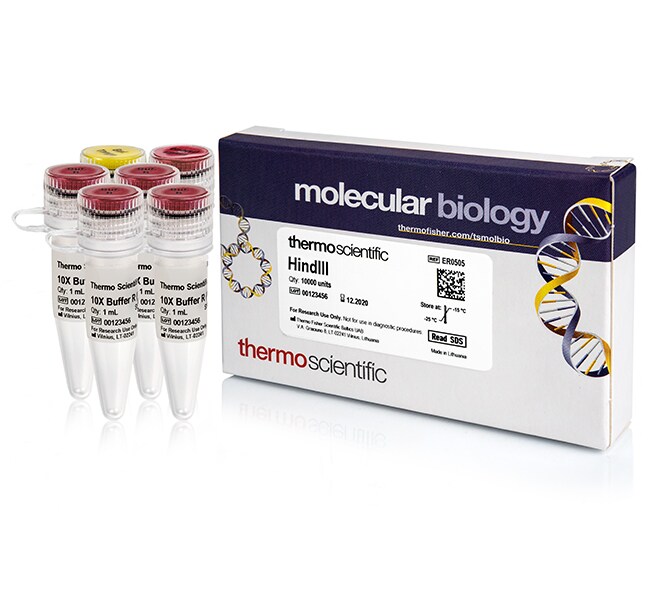Search Thermo Fisher Scientific

Thermo Scientific™
HindIII (10 U/μL)
5' A ↓A G C T T 3' 3' T T C G A ↑A 5' Thermo Scientific HindIII restrictionRead more
| Catalog Number | Quantity |
|---|---|
| ER0505 | 10,000 units |
| ER0502 | 5 x 5,000 units |
| ER0501 | 5,000 units |
Catalog number ER0505
Price (USD)
84.65
Online Exclusive
92.00Save 7.35 (8%)
Each
In stock
Quantity:
10,000 units
Price (USD)
84.65
Online Exclusive
92.00Save 7.35 (8%)
Each
| 5' | A ↓ | A | G | C | T | T | 3' | ||||
| 3' | T | T | C | G | A ↑ | A | 5' |
Thermo Scientific HindIII restriction enzyme recognizes A^AGCTT sites and cuts best at 37°C in R buffer. See Reaction Conditions for Restriction Enzymes for a table of enzyme activity, conditions for double digestion, and heat inactivation for this and other restriction enzymes. Note: Also available as a FastDigest enzyme for rapid DNA digestion.
Thermo Scientific conventional restriction endonucleases are a large collection of high quality restriction enzymes, optimized to work in one of the buffers of the Five Buffer System. In addition, the universal Tango buffer is provided for convenience in double digestions. All of the enzymes exhibit 100% activity in the recommended buffer and reaction conditions. To ensure consistent performance, Thermo Scientific restriction enzyme reaction buffers contain premixed BSA, which enhances the stability of many enzymes and binds contaminants that may be present in DNA preparations.
Features
• Superior quality—stringent quality control and industry leading manufacturing process
• Convenient color-coded Five Buffer System
• Includes universal Tango buffer for double-digestions
• BSA premixed in reaction buffers
• Wide selection of restriction endonuclease specificities
Applications
• Molecular cloning
• Restriction site mapping
• Genotyping
• Southern blotting
• Restriction fragment length polymorphism (RFLP)
• SNP
Note: For methylation sensitivity, refer to product specifications.
For Research Use Only. Not for use in diagnostic procedures.
Specifications
Compatible Buffer10X Buffer R
Product TypeRestriction Enzyme
Quantity10,000 units
Concentration10 U/μL
EnzymeHind III
Methylation SensitivityNot Dam Methylation-Sensitive, Not Dcm Methylation-Sensitive, Not CpG Methylation-Sensitive
Optimal Reaction Temperature37°C
Research CategoryTraditional Cloning
Sensitive to Heat InactivationYes
Type IIS RENo
Unit SizeEach